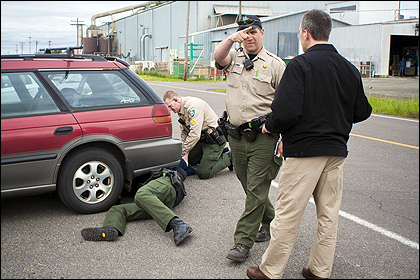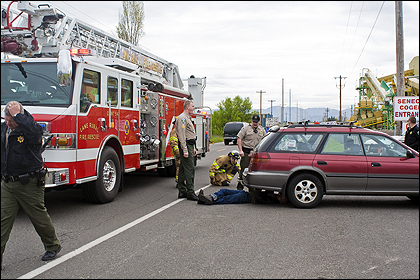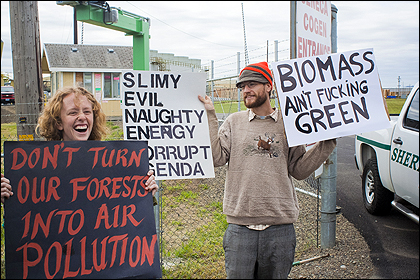Battle Over Biomass
Does Senecas plant violate pollution regs?
Story & Photos By Camilla Mortensen
 |
| *Go away! This is not Eugene.û ‹ Deputy Combs |
 |
| Sheriffs deputies and fire personnel debate how to extract a Seneca protester |
 |
| Erin Grady and other cascadia forest defenders protest at Senecas gates |
A slow procession of cars made its way down East Enid Road off Highway 99 in west Eugene, each turning into the gates of Seneca Sawmills new biomass cogeneration plant and getting checked off by a security officer with a clipboard. For Seneca, and many of its invited guests, the procession was leading to a celebration. For the protesters gathering near the gates, it was leading to a funeral for clean air and for Oregon’s forests.
One protester, Johannes Rune Pedersen, according to Lane County Sheriff’s Office records, was not content to watch the line of cars and shout and sign wave to make his point about the dangers of the biomass plant. He was willing to risk life and limb to get heard.
At a little past 10 am, just as Seneca’s ribbon-cutting event was slated to get under way, Pedersen u-locked himself by the neck to the underside of a station wagon pulling into Seneca’s gates. If the car continued to drive it would drag Pedersen with it, possibly breaking his neck. Within moments the line of cars had ground to a halt, and the area was crawling with angry sheriffs deputies.
Senecas 18.8-megawatt biomass plant has been touted as sustainable energy by Eugene Water and Electric Board (EWEB), which is buying power generated by the wood- burning plant. The Lane Regional Air Protection Agency approved its permit. Its due to get millions in tax credits from Oregons Business Energy Tax Credit (BETC) program for utilizing a “renewable resource” ‹ Oregons forests. So what is it about Seneca Sustainable Energy’s cogeneration plant that brought 25 protesters out on a dreary weekday morning, one of them willing to risk his own neck, to get their voices heard? It turns out that Seneca’s biomass is a bit of a biomess, from its controversial old-growth logging to its maybe not-so-Clean Air Act-approved emissions.
Locking down on biomass
In the first chaotic minutes of Pedersen’s nonviolent direct action, as deputies and state troopers swarmed the scene, it was difficult to ascertain what was going on. Pedersens legs and feet were visible out from under the red Subaru wagon. A tall, burly blonde sheriff was kneeling on them, as if Pedersen was going to suddenly make a break for it, despite the hefty bike lock fastening him to the car. Members of Cascadia Forest Defenders, Ecosystem Advocates Northwest and other protesters held signs proclaiming “Dont Cut Off Our Oxygen,” “Biomass is Not Green” and “Seneca Lies!” and called out to the cars held up by Pedersen’s prone body and the law enforcement vehicles.
Jason Gonzales, a member of CFD, said the deputies refused to let Pedersen’s support crew remain nearby to help ensure his safety. Two other protesters, later identified as Zach Waddell and Emmalyn Garrett, were kneeling, handcuffed, by Seneca’s gates. Gonzales said the deputies had pushed the other protesters away. Most of the demonstrators wound up across the road, or backed against the chainlink and barbed wire fence that rings the plant.
An EW reporter’s attempts to speak to the deputies were loudly and angrily rebuffed by Deputy Marvin Combs with gesticulations and shouts of, “Go away! This is not Eugene!”
To be precise, Seneca Sustainable Energy (SSE) is not exactly in Eugene; it is just outside the city limits. It is thus exempt from the Eugene Toxics Right-to-Know ordinance that would allow Eugenean’s to see what chemicals the plant is using. But what it will emit is on record, thanks to its air pollution permit.
The plant will release 200,000 tons of carbon dioxide, 185.61 tons of nitrogen oxides, 200.89 tons of carbon monoxide, 1.7 tons of formaldehyde and more than 13 tons each of PM 10 and PM 2.5 (particulate matter) over the course of a year. Lisa Arkin of Oregon Toxics Alliance (OTA), which did not participate in the protest but has fought Seneca’s permit from the beginning, said, “You may not be in the city limits, but you’re in our airshed.”
Seneca is “refusing to acknowledge that their emissions move away from the facility,” and into the city, she said.
Gonzales said protesters also had been met with the shouts of “This ain’t Eugene,” as well as with physical force. A neutral observer with the National Lawyers Guild and trained by Eugene-based Civil Liberties Defense Center monitored the events. Lauren Regan of the CLDC said the overreaction from law enforcement might have been due to an assumption that øtheres going to be a longstanding campaign with the plant as target,” and she surmised the deputies were trying to frighten protesters so they wouldn’t come back.
The biomass burning issue, Regan said, is not one thats going to go away, and its an “issue thats going to attract a lot of public attention; it will impact a large portion of the community and Seneca needs to be ready for the public to express its grievances.”
Regan continued, “This is a long-term campaign that the activists have put together and were going to support it on the legal side.” She said the protesters “are well trained on their legal rights,” and CLDC will have legal observers to monitor future events and the actions of police as well as protesters.
Seneca “could change that by deciding not to become a biomass plant, but thats very unlikely,” Regan pointed out.
The fire department arrived with equipment to break the lock holding the protester to the car. Bill Thompson, a captain with the sheriff’s office, wearing a light blue sport coat instead of the deputies’ brown and tan uniform, answered questions after Pedersen was cut loose.
Thompson said that the invitation-only Seneca event featured community leaders and politicians, and that “folks from Cascadia Forest Defenders feel strongly this project is not in the best interest of the environment.” He clarified that it was not clear if Pedersen, Garrett or Waddell were associated with CFD. According to Thompson, Garrett and Waddell had blocked the Subaru as it entered Senecas gates while “the third subject” climbed beneath the car and locked himself to it.
Lane County jail records show that they were all charged with disorderly conduct in the second degree, a misdemeanor.
Nathaniel, a Cascadia Forest Defender who declined to give his last name, said he was protesting Seneca because he was “tired of seeing false solutions and greenwashing marketed to a community like Eugene that is very susceptible to it.” He said that he works in the forest, and what is left after trees and slash have been removed for biomass is øa moonscape.” The forest, he said, needs decaying dead trees and snags to sustain it. “I’d rather they’d be burning coal,” Nathaniel said of Seneca, because “then you could see the pollution.”
A controversial 2010 study on biomass by the Manomet Center for Conservation Sciences commissioned by the state of Massachusetts showed that burning wood initially emits more greenhouse gases than fossil fuels. Some scientists say the emissions are balanced when the forest is replanted, but others say the carbon cycle is far more complex than that (see EWs cover feature “Biomess,” 2/22/2010).
The biomass we breathe
While forest advocates debate whether biomass extraction is actually “renewable,” social justice advocates such as Lisa Arkin are concerned with the effects that burning wood will have on the lungs of the elderly and those of young children.
Seneca has argued in editorials and in meetings — the company did not respond to requests for an interview for this story —hat burning logging slash in a factory with pollution controls is healthier than burning it in the forest and that it is using the best available technology. Arkin said that the LRAPA permit and pollution controls “dont mean that the air coming out of the stacks is clean air; its actually highly polluted air.” And the burning will go on every day, she said, constantly affecting those who live nearby, as opposed to rotating through the forests outside the city. Forest advocates argue the slash shouldn’t be burned at all, but left in the forest for nutrients and as habitat.
And Arkin said, when Eugene has a bad air day, “People can’t burn their woodstoves, but Seneca can keep burning.”
OTA has fought successfully for better air quality monitoring in west Eugene, and LRAPA got a federal grant in 2010 to help pay for increased monitoring. OTA also fought Senecas LRAPA permit and lost. The group argued that Seneca cogeneration should not have been given a separate air pollution permit from Seneca Sawmill.
LRAPA Director Merlyn Hough said that the cogen plant “met the requirements for a separate permitted facility.” LRAPA addressed the issue in its responses to public comments on the SSE permit and wrote that the criteria pollutant levels from the plant did not trigger LRAPA or a federal ø”new source review.” Hough said even if the facilities were combined øthe combined emissions of hazardous air pollutant (or HAPs, and also referred to as air toxics) must still be below the 10/25 tons per year thresholds.”
LRAPA’s decision to permit SSE separately from the sawmill was based on the plants having two different standard industrial classifications (SIC) codes, despite the fact that the facilities are located on contiguous or adjacent properties and owned and operated by the same corporation. LRAPA saw SSE not as a support to the sawmill but as an independent power generator. LRAPA’s arguments appear to be based on the arguments made by Seneca itself in its 2009 permit application.
But the question of whether Seneca is ripe for a citizen lawsuit under the Clean Air Act lingers. One could argue under the act that the incinerator is in fact a support facility for the mill and that the combined facilities emit enough particulate matter to trigger a new source review under the Clean Air Act.
For example, in 2009 Seneca Sawmill said it would be emitting fewer hazardous air pollutants, and Seneca Vice President Rick Re wrote on the application to modify the permit, “With construction of the new SSE cogeneration plant, the natural gas boiler only will be used when the power plant is not operating,” which arguably means the cogen plant operates in support of the sawmill. Something perhaps for a judge to decide.
But until that happens, protesters say Seneca will continue to come under fire for polluting Eugenes air and cutting down Oregon’s forest
Forest for the trees
Biomass burning to generate electricity is about clean air in Eugene but also about the forests around it. That fact was hit home when a log truck bringing a load of timber to Seneca sawmill raced by the protesters so fast that its wind and blaring horn startled Ceila Starshine Levine and blew her into a ditch as she stood on the side of the road holding a sign reading, “Biomass Burning Destroys Our Forests.”
In response to a question from EW about the legality of the truck speeding by the protest, Deputy Combs, standing in front of Seneca gate the truck had turned into, asked “What truck?”
The speeding truck, the angry logger behind the wheel and belligerent law enforcement bring to mind the face-offs between loggers and activists during the logging wars of the Northwest in the 1990s. But these days, with only a few exceptions, its energy and climate change, not old growth, that are causing the clashes between corporations and ecowarriers.
Will Potter, author of Green is the New Red, who will be speaking on “ecoterrorism” at the UO May 17, said after a “lull in the amount of both underground actions and more public direct action,” there has been a resurgence of protests about hot button issues of energy and climate change. And a ødisproportionate police response” has been a factor in environmental civil obedience all along.
Seneca is involved in both the energy issue and the old growth issue: As Seneca Sustainable Energy, its burning wood in its biomass cogeneration plant, and as Seneca Jones Timber Company and Seneca Sawmill its logging Oregons forests, then cutting the trees up in the mill adjoining SSE.
EWEB Commissioner Joann Ernst came to the Seneca protest not to address the biomass issue, but to take on Seneca for its ongoing efforts to log an old growth forest, the Trapper timber sale in the McKenzie River watershed — the source of Eugenes clean water.
“Seneca is being a very bad neighbor cutting down old growth when its been offered an alternative,” Ernst said.
Trapper, as well as tracts in the Elliott State Forest, which Seneca also logs, has been the locus of treesits and other protests. But according to Samantha Chirillo of Ecosystem Advocates Northwest, also present at the Seneca protest, last weeks arrests marks the first time activists have been arrested protesting biomass.
Seneca is “a company that doesn’t care about this states forests,” said Erin Grady, a point person for CFD.
Biomessy Energy
EWEB has agreed to purchase some of Seneca’s subsidized energy to replace what it is losing when the Bonneville Power Administration (BPA) changes the way it allocates power. EWEB spokesman Lance Robertson said this fall EWEB will lose 10 to 15 percent of cheap BPA power and needs to replace it. He estimates that Seneca can supply about 5 or 6 percent of that power EWEB needs. It wont be as cheap as BPA power because renewable energy is more expensive than other sources, Robertson said. But he said EWEB wanted to stay with local energy sources. Seneca was going to sell the energy either way, and there is “an advantage to a local entity purchasing that power rather than other entities outside the state.”
Is biomass renewable energy? “The Oregon Legislature has designated biomass as a renewable resource under the states renewable energy portfolio,” Robertson said. He said an EWEB citizens committee that started meeting about two months ago will discuss, among other issues, whether biomass is a viable option in the future.
Though the chances of valuable old growth trees winding up as biomass are probably slim, their branches and other logging “waste” that is often burnt in the forest as slash could wind up generating energy for EWEB and so for Eugene homes. But according to Chirillo, “The fact is that they wont rule out logging for fuel. We cant see what is in the contract, so we can’t rule out that were burning old growth forests.”
“Its not speculation that Seneca is going to chip and burn whole trees,” Chirillo said. Other Oregon biomass plants, she said, are chipping “non-merchantable trees” which are too small to make into two-by-fours.
Chirillo added that biomass industry is dependent on subsidies. “Other states like Massachusetts are cutting back on subsidies,” and she said if the subsidies begin to dry up or are restricted in the future then biomass as a source of energy isnt as reliable as people think. In January, the EPA deferred regulating greenhouse gas emissions from biomass burning for three years to assess the global warming consequences of burning wood for energy.
Just how much in subsidies is Seneca actually getting? According to Diana Enright, communications manager for the Oregon Department of Energy, Seneca Sustainable Energy applied for a BETC in January 2009, and got a preliminary certification for up to a $10 million tax credit , 50 percent of the eligible project cost of $20 million. She said there were changes in 2010 to BETC, and SSE will not get a tax credit until the project is completed and the paperwork is reviewed. She said the Oregon DOE has not yet received the final BETC application from SSE. According to DOE documents, Seneca also received about $170,000 in stimulus funding for variable frequency drive upgrades on its new plant.
According to the Cascadia Forest Defenders, “The only thing green about this plant is the money.”